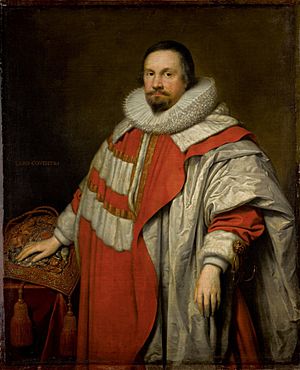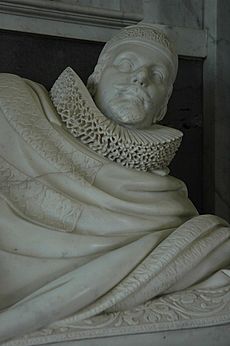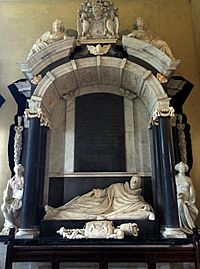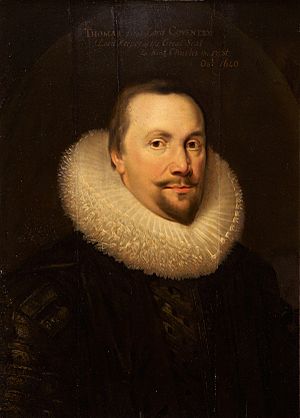Thomas Coventry, 1st Baron Coventry facts for kids
Quick facts for kids
The Lord Coventry
|
|
|---|---|
 |
|
| Lord Keeper of the Great Seal of England | |
| In office 1625–1640 |
|
| Monarch | Charles I |
| Preceded by | John Williams |
| Succeeded by | The Lord Finch |
| Personal details | |
| Born | 1578 |
| Died | 14 January 1640 (aged 61) |
Thomas Coventry, 1st Baron Coventry (1578–14 January 1640) was an important English lawyer, politician, and judge in the early 1600s. He held a very powerful position as the Lord Keeper of the Great Seal for many years under King Charles I.
Contents
Early Life and Legal Training
Thomas Coventry began his education at Balliol College, Oxford, in 1592. Later, in 1594, he joined the Inner Temple, which is one of the professional associations for barristers in London. He quickly showed great skill in law.
Rising Through the Legal Ranks
Because of his talent, he was promoted early in his career.
- In 1614, he became a "bencher," a senior member of the Inner Temple.
- In 1616, he became a "reader," which meant he taught law to other students.
- From 1617 to 1621, he served as the "treasurer" of the Inner Temple, managing its finances.
On November 16, 1616, he was made the Recorder of London. This was a top legal job for the City of London. Even though Francis Bacon, another famous lawyer, didn't fully support him, Coventry still got the position. Bacon noted that Coventry was "well trained" and "honest." On March 14, 1617, he became the Solicitor General, a chief legal advisor to the government, and was knighted by the King.
Political and Judicial Career
Thomas Coventry was elected to the Parliament for Droitwich in 1621. On January 11, 1621, he was appointed Attorney General. This meant he was the chief lawyer for the Crown.
Key Roles in Parliament and Court
He played a part in the legal proceedings against Francis Bacon for corruption. He also helped the House of Commons in the case against Edward Floyd. Floyd was accused of insulting the Elector and Electress Palatine, who were important royal figures.
On November 1, 1625, Coventry was given the very important job of Lord Keeper of the Great Seal. This role was similar to a modern-day Lord Chancellor, overseeing the justice system. In this position, he delivered King Charles I's message to Parliament on March 9, 1626. He told them they had "liberty of counsel" (freedom to discuss) but not "liberty of control" (freedom to make decisions without the King).
Supporting the King's Power
On April 10, 1628, he was given the title Baron Coventry of Aylesborough. When Parliament opened in 1628, he warned that the King would use his special powers if Parliament didn't provide enough money.
In later discussions, he supported the King's power against Parliament's demands. He believed the King's Privy Council could imprison people without giving a reason in special cases. He also supported "general warrants," which allowed broad searches. However, he disagreed with the King suddenly ending Parliament. He also agreed to release seven imprisoned members of Parliament on bail, as long as they promised good behavior.
Challenges with the Duke of Buckingham
Coventry was less willing to obey the Duke of Buckingham than some others. He opposed Buckingham's desire to become Lord High Constable. Buckingham, who was a favorite of the King, teased Coventry, saying Coventry owed his job to him. Coventry bravely replied that if he thought he got his job through Buckingham, he would immediately resign. Buckingham's sudden death likely saved Coventry's position.
Important Legal Decisions
In 1631, he oversaw the trial of Lord Audley. In 1632, he helped draft a rule telling country gentlemen to leave London. In 1634, he supported William Laud's accusations against the Earl of Portland for stealing money.
That same year, he supported the idea of collecting "ship money" from inland areas, not just coastal ones. He argued it was necessary to prepare the country's defenses. He believed "wooden walls" (ships) were the best defense for England.
In the Star Chamber, a special court, Coventry was one of the judges for John Lilburne in 1637. However, he often showed fairness and leniency. For example, he was softer in the cases of Richard Chambers (1629) for rebellious speeches and Henry Sherfield (1632) for breaking church windows. He also stopped the hanging of men who resisted being forced into military service, pointing out it was illegal.
Even though he helped fund the Scottish expedition in 1638 and lent the King money in 1639, he did not support a forced loan on the city that same year.
Legacy and Character

Lord Coventry held the Great Seal for almost 15 years, from 1625 to 1640. During this time, he became very wealthy. He was known as a skilled judge and made important changes to the court system.
Many people at the time praised his legal ability and how quickly he handled cases. Clarendon, a famous historian, particularly admired his skills as a statesman. Clarendon said Coventry was "exceedingly liked" rather than "passionately loved." He also noted that Coventry usually only spoke about legal matters in the King's council, which helped him stay popular.
Family Life

Thomas Coventry was the oldest son of Sir Thomas Coventry, who was also a judge. His family had a long history, including an ancestor who was Lord Mayor of London in the time of King Henry VI. His mother was Margaret Jeffreys.
Thomas Coventry was married twice:
- His first wife was Sarah Sebright. They had one son and a daughter:
- Thomas, who became the 2nd Baron after his father.
- His second wife was Elizabeth Aldersley. They had four more sons and four more daughters:
- John, whose son was Sir John Coventry.
- Francis.
- Henry, who became a Secretary of State later (1672–1680).
- Sir William Coventry, another important statesman.
- Anne, who married Sir William Savile, 3rd Baronet and then Thomas Chicheley.
- Mary, who married Sir Henry Frederick Thynne, 1st Baronet.
- Margaret, who married Sir Anthony Ashley-Cooper.
- Dorothy, who married Sir John Pakington, 2nd Baronet.
Later, Thomas Coventry, the 5th Baron, was made Earl of Coventry in 1697. The current Earl of Coventry is descended from Walter, who was the youngest brother of the 1st Lord Keeper.


